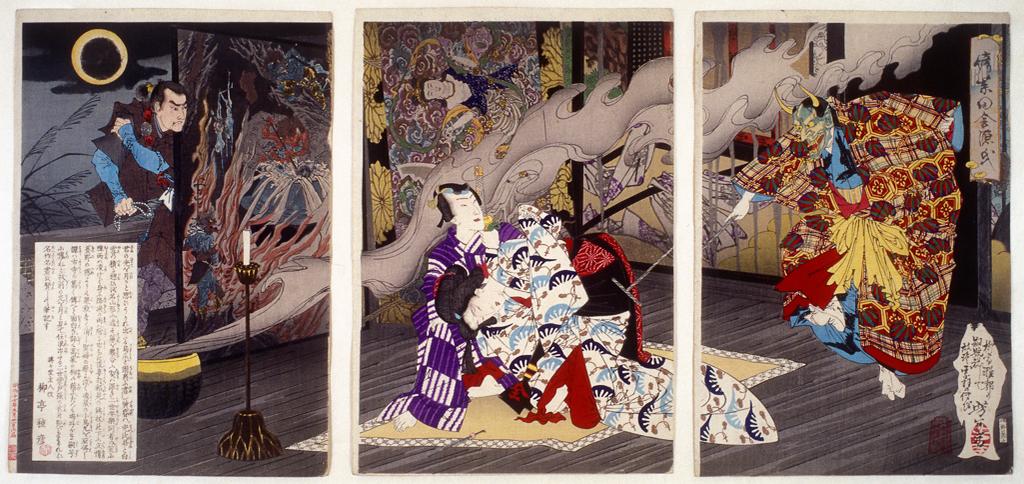
Colour print from woodblocks, with blind embossing (karazuri), textile printing (nunomezuri)
and gloss black (tsuyazumi).
Ôban format triptych.
Block-cutter: Horikô Noguchi Enkatsu.
Publisher: Akiyama (Akiyama Buemon). 21/05/1883
Keyes 463
The title comes from Ryutei Tanehiko’s serial novel Nise murasaki inaka genji (False Murasaki and a Rural Genji) of 1829-42, which reset the 11th-century classic Tale of Genji in the 15th century, with a cynical hero, and narrative conventions borrowed from popular novels, kabuki and puppet theatre, replacing the melancholy poetic tone of the original. This scene comes from chapter 4.
The protagonist Mitsuuji and his lover Tasogare escape from the watch of Tasogare’s widowed mother, Shinonome, to spend the night together in a dilapidated temple. A wicked demon appears, intent on murdering Mitsuuji; this is actually Shinonome in disguise. Mitsuuji announces that he knew all along that is was she, working for his enemies, who stole a family sword that he is trying to recover; his love affair with Tasogare was a mere pretext to help find the sword. The mortified Tasogare commits suicide, and the grief-stricken Shinonome follows suit. The man on the left is one of Shinonome’s henchmen.
The popularity of Tanehiko’s novel, and Kunisada’s illustrations to the first edition, inspired something of a Genji craze, with associated hair-fashions and product names, and dramatised versions of the book. The illustrations provoked a new category of prints, Genji-e (Genji pictures), based on Tanehiko’s plot rather than the Heian-period original. Many of these were made by Kunisada and his pupils. Click here for a Rural Genji print by Kunisada
Kunisada made a triptych of this same scene in 1851, marking the production of two kabuki dramatisations of the novel in the autumn of that year. Although Yoshitoshi was obviously influenced by these earlier versions, his own version is typically individual in terms of its complex design, colour and emotional intensity. In showing Shinonome threatening Tasogare rather than Mitsuuji, he brings it closer to the scene in chapter 4 of the original Genji, in which the spirit of a neglected lover kills Genji’s new lover Yugao during the night. The pattern on Mitsuuji’s costume is based on the traditional symbol (Genjimon) for chapter 4 of Genji.
Purchased from the Rylands Fund with a contribution from the National Art Collections Fund, 2003




